Assessment of Land Surface Temperature Estimates from Landsat 8-TIRS in A High-Contrast Semiarid Agroecosystem. Algorithms Intercomparison
Abstract
:1. Introduction
- To assess the performance of traditional LST algorithms applied to L8/TIRS after the recalibration implemented in the new Collection 2 under the conditions of a semiarid agroecosystem.
- Explore the feasibility of the new LST Level 2 operational product for agricultural applications in our site.
- Introduce a new procedure to derive atmospheric correction parameters as part of a novel algorithm to estimate LST from L8/TIRS, reducing processing time and preserving accuracy.
2. Methods
2.1. Land Surface Temperature Retrieval Algorithms
2.1.1. Jimenez-Muñoz Single-Channel Algorithm
2.1.2. The Single Band Atmospheric Correction (SBAC)
2.1.3. Linear Approach for SBAC (L-SBAC)
2.1.4. Jiménez-Muñoz Split-Window Algorithm
2.1.5. Du Split-Window Algorithm
2.1.6. Split-Window Based on CLAR Database
2.2. Landsat 8 LST L2 Product
2.3. Emissivity and Water Vapor Content Inputs
2.3.1. Emissivity Estimation
2.3.2. Spatially Distributed Total Column Water Vapor Content
- Data from the NCEP global tropospheric analyses product are used. This product provides atmospheric profiles of temperature, air humidity, and geopotential height in several constant pressure levels every 6 h.
- The SBAC interpolation method defines a tri-dimensional grid with nodes latitude-longitude and thirteen height levels from 0 to 5000 m above the sea. Every node/level coordinate is filled with a calculated W from an atmospheric profile above the determinate level, temporally interpolated between the two closest in time products prior to and after the sensor overpass.
- Once a pixel is selected, the eighteen closest nodes-levels are activated (nine above and nine below of selected pixels) based on the corresponding latitude, longitude, and height above sea level.
- Weighted spatial interpolation, with the distance square as a basis, is used to obtain W only in the level above and below the desired pixel. Finally, a linear interpolation between two levels yields the w value for the selected pixel.
2.4. Evaluation Statistics
3. Study Site and Measurements
4. Results
4.1. Ground Measurements and Satellite Brightness Temperatures
4.2. Single-Channel LST
4.3. Split-Window LST
5. Discussions
6. Conclusions
Author Contributions
Funding
Data Availability Statement
Acknowledgments
Conflicts of Interest
References
- Anderson, M.C.; Allen, R.G.; Morse, A.; Kustas, W.P. Use of Landsat thermal imagery in monitoring evapotranspiration and managing water resources. Remote Sens. Environ. 2012, 122, 50–65. [Google Scholar] [CrossRef]
- Trigo, I.F.; Boussetta, P.S.; Viterbo, G.; Balsamo, A.; Sandu, I. Comparison of model land skintemperature with remotely sensedestimates and assessment of surface-atmosphere coupling. J. Geophys. Res. Atmos. 2015, 120, 12096–12111. [Google Scholar] [CrossRef] [Green Version]
- Fisher, J.B.; Melton, F.; Middleton, E.; Hain, C.; Anderson, M.; Allen, R.; McCabe, M.F.; Hook, S.; Baldocchi, D.; Townsend, P.A.; et al. The future ofevapotranspiration: Globalrequirements for ecosystemfunctioning, carbon and climatefeedbacks, agricultural management, and water resources. Water Resour. Res. 2017, 53, 2618–2626. [Google Scholar] [CrossRef]
- Guillevic, P.; Göttsche, F.; Nickeson, J.; Hulley, G.; Ghent, D.; Yu, Y.; Trigo, I.; Hook, S.; Sobrino, J.A.; Remedios, J.; et al. Land surface temperature product validation best practice protocol version 1.1. Best Pract. Satell.-Deriv. Land Prod. Valid. 2018. Available online: https://lpvs.gsfc.nasa.gov/PDF/CEOS_LST_PROTOCOL_Feb2018_v1.1.0_light.pdf (accessed on 15 January 2022).
- Su, H.; McCabe, M.; Wood, E.F.; Su, Z.; Prueger, J. Modeling evapotranspiration during SMACEX: Comparing two approaches for local-and regional-scale prediction. J. Hydrometeorol. 2005, 6, 910–922. [Google Scholar] [CrossRef]
- Kalma, J.D.; McVicar, T.R.; McCabe, M.F. Estimating Land Surface Evaporation: A Review of Methods Using Remotely Sensed Surface Temperature Data. Surv. Geophys. 2008, 29, 421–469. [Google Scholar] [CrossRef]
- Sánchez, J.M.; Scavone, G.; Caselles, V.; Valor, E.; Copertino, V.A.; Telesca, V. Monitoring daily evapotranspiration at a regional scale from Landsat-TM and ETM+ data: Application to the Basilicata region. J. Hydrol. 2008, 351, 58–70. [Google Scholar] [CrossRef]
- Kustas, W.P.; Alfieri, J.G.; Nieto, H.; Wilson, T.G.; Gao, F.; Anderson, M.C. Utility of the two-source energy balance (TSEB) model in vine and interrow flux partitioning over the growing season. Irrig. Sci. 2019, 37, 375–388. [Google Scholar] [CrossRef]
- Food and Agriculture Organization of United Nations. Innovation in Family Farming; The State of Food and Agriculture: Rome, Italy, 2014; E-ISBN 978-92-5-108537-0. [Google Scholar]
- Tilman, D.; Cassman, K.G.; Matson, P.A.; Naylor, R.; Polasky, S. Agricultural sustainability and intensive production practices. Nature 2002, 418, 671–677. [Google Scholar] [CrossRef]
- Garnett, T.; Appleby, M.C.; Balmford, A.; Bateman, I.J.; Benton, T.G.; Bloomer, P.; Burlingame, B.; Dawkins, M.; Dolan, L.; Fraser, D.; et al. Sustainable Intensification in Agriculture: Premises and Policies. Sci. Mag. 2013, 341, 33–34. [Google Scholar] [CrossRef]
- Wulder, M.A.; White, J.C.; Loveland, T.R.; Woodcock, C.E.; Belward, A.S.; Cohen, W.B.; Fosnight, E.A.; Shaw, J.; Masek, J.G.; Roy, D.P. The global Landsat archive: Status, consolidation, and direction. Remote Sens. Environ. 2016, 185, 271–283. [Google Scholar] [CrossRef] [Green Version]
- Dwyer, J.L.; Roy, D.P.; Sauer, B.; Jenkerson, C.B.; Zhang, H.K.; Lymburner, L. Analysis Ready Data: Enabling Analysis of the Landsat Archive. Remote Sens. 2018, 10, 1363. [Google Scholar] [CrossRef]
- Irons, J.R.; Dwyer, J.L.; Barsi, J.A. The next landsat satellite: The landsat data continuity mission. Remote Sens. Environ. 2012, 122, 11–21. [Google Scholar] [CrossRef] [Green Version]
- Montanaro, M.; Barsi, J.; Lunsford, A.; Rohrbach, S.; Markham, B. Performance of the Thermal Infrared Sensor on-board Landsat 8 over the first year on-orbit. In Proceedings of the Earth Observing Systems XIX, San Diego, CA, USA, 17–21 August 2014; p. 921817. [Google Scholar] [CrossRef]
- Barsi, J.A.; Lee, K.; Kvaran, G.; Markham, B.L.; Pedelty, J.A. The Spectral Response of the Landsat-8 Operational Land Imager. Remote Sens. 2014, 6, 10232–10251. [Google Scholar] [CrossRef] [Green Version]
- Gerace, A.; Montanaro, M. Derivation and validation of the stray light correction algorithm for the thermal infrared sensor onboard landsat 8. Remote Sens. Environ. 2017, 191, 246–257. [Google Scholar] [CrossRef]
- Guo, J.; Ren, H.; Zheng, Y.; Lu, S.; Dong, J. Evaluation of Land Surface Temperature Retrieval from Landsat 8/TIRS Images before and after Stray Light Correction Using the SURFRAD Dataset. Remote Sens. 2020, 12, 1023. [Google Scholar] [CrossRef] [Green Version]
- Niclòs, R.; Puchades, J.; Coll, C.; Barberà, M.J.; Pérez-Planells, L.; Valiente, J.A.; Sánchez, J.M. Evaluation of Landsat-8 TIRS data recalibrations and land surface temperature split-window algorithms over a homogeneous crop area with different phenological land covers. ISPRS J. Photogramm. Remote Sens. 2021, 174, 237–253. [Google Scholar] [CrossRef]
- Wang, M.; Zhang, Z.; Hu, T.; Liu, X. A Practical Single-Channel Algorithm for Land Surface Temperature Retrieval: Application to Landsat Series Data. J. Geophys. Res. Atmos. 2019, 124, 299–316. [Google Scholar] [CrossRef]
- Duan, S.-B.; Li, Z.-L.; Wang, C.; Zhang, S.; Tang, B.-H.; Leng, P.; Gao, M.-F. Land-surface temperature retrieval from Landsat 8 single-channel thermal infrared data in combination with NCEP reanalysis data and ASTER GED product. Int. J. Remote Sens. 2019, 40, 1763–1778. [Google Scholar] [CrossRef]
- Sayler, K. Landsat 8-9 Collection 2 Level 2 Science Product Guide. 2020. Available online: https://www.usgs.gov/media/files/landsat-8-collection-2-level-2-science-product-guide (accessed on 15 January 2022).
- Pérez-Planells, L.; García-Santos, V.; Caselles, V. Comparing different profiles to characterize the atmosphere for three MODIS TIR bands. Atmos. Res. 2015, 161, 108–115. [Google Scholar] [CrossRef] [Green Version]
- Coll, C.; Caselles, V.; Valor, E.; Niclòs, R. Comparison between different sources of atmospheric profiles for land surface temperature retrieval from single channel thermal infrared data. Remote Sens. Environ. 2012, 117, 199–210. [Google Scholar] [CrossRef]
- Kalnay, E.; Kanamitsu, M.; Kistler, R.; Collins, W.; Deaven, D.; Gandin, L.; Iredell, M.; Saha, S.; White, G.; Woollen, J.; et al. The NCEP/NCAR 40-year reanalysis project. Bull. Am. Meteorol. Soc. 1996, 77, 437–471. [Google Scholar] [CrossRef] [Green Version]
- Seemann, S.W.; Borbas, E.E.; Li, J.; Menzel, W.P.; Gumley, L.E. MODIS Atmospheric Profile Retrieval Algorithm Theoretical Basis Document. Madison, WI: Univ. Wisconsin-Madison. 2006. Available online: http://modis-atmos.gsfc.nasa.gov/reference_atbd.html (accessed on 15 January 2022).
- Divakarla, M.G.; Barnet, C.D.; Goldberg, M.D.; McMillin, L.M.; Maddy, E.; Wolf, W.; Zhou, L.; Liu, X. Validation of Atmospheric Infrared Sounder temperature and water vapor retrievals with matched radiosonde measurements and forecasts. J. Geophys. Res. 2006, 111, D09S15. [Google Scholar] [CrossRef] [Green Version]
- Barsi, J.A.; Schott, J.R.; Palluconi, F.D.; Hook, S.J. Validation of a web-based atmospheric correction tool for single thermal band instruments. In Proceedings of the Earth Observing Systems X, San Diego, CA, USA, 31 July–4 August 2005; Volume 5882, p. 58820E. [Google Scholar] [CrossRef]
- Coll, C.; Galve, J.M.; Sanchez, J.M.; Caselles, V. Validation of Landsat-7/ETM+ thermal-band calibration and atmospheric correction with ground-based measurement. IEEE Trans. Geosci. Remote Sens. 2010, 48, 547–555. [Google Scholar] [CrossRef]
- Galve, J.M.; Sánchez, J.M.; Coll, C.; Villodre, J. A New Single-Band Pixel-by-Pixel Atmospheric Correction Method to Improve the Accuracy in Remote Sensing Estimates of LST. Application to Landsat 7-ETM+. Remote Sens. 2018, 10, 826. [Google Scholar] [CrossRef] [Green Version]
- Li, Z.; Tang, B.; Wu, H.; Ren, H.; Yan, G.; Wan, Z.; Trigo, L.F.; Sobrino, J.A. Satellite-derived land surface temperature: Current status and perspectives. Remote Sens. Environ. 2013, 131, 14–37. [Google Scholar] [CrossRef] [Green Version]
- Jimenez-Munoz, J.C.; Cristobal, J.; Sobrino, J.A.; Soria, G.; Ninyerola, M.; Pons, X. Revision of the Single-Channel Algorithm for Land Surface Temperature Retrieval From Landsat Thermal-Infrared Data. IEEE Trans. Geosci. Remote Sens. 2009, 47, 339–349. [Google Scholar] [CrossRef]
- Jiménez-Muñoz, J.C.; Sobrino, J.A.; Skoković, D.; Mattar, C.; Cristóbal, J. Land Surface Temperature Retrieval Methods From Landsat-8 Thermal Infrared Sensor Data. IEEE Geosci. Remote Sens. Lett. 2014, 11, 1840–1843. [Google Scholar] [CrossRef]
- Mattar, C.; Durán-Alarcón, C.; Jiménez-Muñoz, J.C.; Santamaría-Artigas, A.; Olivera-Guerra, L.; Sobrino, J.A. Global Atmospheric Profiles from Reanalysis Information (GAPRI): A new database for earth surface temperature retrieval. Int. J. Remote Sens. 2015, 36, 5045–5060. [Google Scholar] [CrossRef]
- Berk, A.; Anderson, G.P.; Acharya, P.K.; Bernstein, L.S.; Muratov, L.; Lee, J.; Fox, M.; Adler-Golden, S.M.; Chetwynd, J.H.; Hoke, M.L.; et al. MODTRAN5: 2006 Update. In Proceedings of the Algorithms and Technologies for Multispectral, Hyperspectral, and Ultraspectral Imagery XII, Orlando, FL, USA, 8 May 2006; Volume 6233, p. 62331F. [Google Scholar] [CrossRef]
- Berk, A.; Anderson, G.P.; Acharya, P.K.; Shettle, E.P. MODTRAN®5.2.1 User’s Manual; Spectral Sciences Inc.: Burlington, MA, USA, 2011; Available online: https://citeseerx.ist.psu.edu/viewdoc/download?doi=10.1.1.458.1743&rep=rep1&type=pdf (accessed on 15 January 2022).
- Coll, C.; Galve, J.M.; Niclòs, R.; Valor, E.; Barberà, M.J. Angular variations of brightness surface temperatures derived from dual-view measurements of the Advanced Along-Track Scanning Radiometer using a new single band atmospheric correction method. Remote Sens. Environ. 2019, 223, 274–290. [Google Scholar] [CrossRef]
- Galve, J.M.; Coll, C.; Caselles, V.; Valor, E. An Atmospheric Radiosounding Database for Generating Land Surface Temperature Algorithms. IEEE Trans. Geosci. Remote Sens. 2008, 46, 1547–1557. [Google Scholar] [CrossRef]
- McMillin, L.M. Estimation of sea surface temperatures from two infrared window measurements with different absorption. J. Geophys. Res. 1975, 80, 5113–5117. [Google Scholar] [CrossRef]
- Sobrino, J.A.; Li, Z.-L.; Stoll, M.P.; Becker, F. Multi-channel and multi-angle algorithms for estimating sea and land surface temperature with ATSR data. Int. J. Remote Sens. 1996, 17, 2089–2114. [Google Scholar] [CrossRef]
- Coll, C.; Caselles, V. A global split-window algorithm for land surface temperature from AVHRR data: Validation and algorithm comparison. J. Geophys. Res. 1997, 102D, 16697–16713. [Google Scholar] [CrossRef]
- Du, C.; Ren, H.; Qin, Q.; Meng, J.; Zhao, S. A Practical Split-Window Algorithm for Estimating Land Surface Temperature from Landsat 8 Data. Remote Sens. 2015, 7, 647–665. [Google Scholar] [CrossRef] [Green Version]
- Wan, Z.; Dozier, J. A generalized split-window algorithm for retrieving land-surface temperature from space. IEEE Trans. Geosci. Remote Sens. 1996, 34, 892–905. [Google Scholar] [CrossRef] [Green Version]
- Wan, Z.; Dozier, J. Land-surface temperature measurement from space: Physical principles and inverse modeling. IEEE Trans. Geosci. Remote Sens. 1989, 27, 268–277. [Google Scholar] [CrossRef] [Green Version]
- Cook, M.; Schott, J.R.; Mandel, J.; Raqueno, N. Development of an Operational Calibration Methodology for the Landsat Thermal Data Archive and Initial Testing of the Atmospheric Compensation Component of a Land Surface Temperature (LST) Product from the Archive. Remote Sens. 2014, 6, 11244–11266. [Google Scholar] [CrossRef] [Green Version]
- Hulley, G.C.; Hook, S.J.; Abbott, E.; Malakar, N.; Islam, T.; Abrams, M. The ASTER Global Emissivity Dataset (ASTER GED): Mapping Earth’s emissivity at 100 m spatial scale. Geophys. Res. Lett. 2015, 42, 7966–7976. [Google Scholar] [CrossRef]
- Valor, E.; Caselles, V. Mapping Land Surface Emissivity from NDVI: Application to European, African and South American Areas. Remote Sens. Environ. 1996, 57, 167–184. [Google Scholar] [CrossRef]
- Valor, E.; Caselles, V. Validation of the vegetation cover method for land surface emissivity estimation. In Recent Research Developments in Thermal Remote Sensing; Research Singpost: Kerala, India, 2005; pp. 1–20. [Google Scholar]
- Hulley, G.C.; Hook, S.J. The North American ASTER Land Surface Emissivity Database (NAALSED). Version 2.0. Remote Sens. Environ. 2009, 113, 1967–1975. [Google Scholar] [CrossRef]
- Baldridge, A.M.; Hook, S.J.; Grove, C.I.; Rivera, G. The ASTER spectral library version 2.0. Remote Sens. Environ. 2009, 113, 711–715. [Google Scholar] [CrossRef]
- Duchemin, B.; Hadria, R.; Er-Raki, S.; Boulet, G.; Maisongrande, P.; Chehbouni, A.; Escadafal, R.; Ezzahar, J.; Hoedjes, J.C.B.; Kharrou, M.H.; et al. Monitoring wheat phenology and irrigation in central Morocco on the use of relationships between evapotranspiration, crop coefficients, leaf area index and remotely-sensed vegetation indices. Agric. Water Manag. 2006, 79, 1–27. [Google Scholar] [CrossRef]
- Asrar, G.; Fuchs, M.; Kanemasu, E.T.; Hatfield, J.L. Estimating absorbed photosynthetic radiation and leaf area index from spectral reflectance in wheat. Agron. J. 1984, 76, 300–306. [Google Scholar] [CrossRef]
- Moreno, J.F.; Alonso, L.; Fernàndez, G.; Fortea, J.C.; Gandía, S.; Guanter, L.; Garcia, J.C.; Martí, J.M.; Melia, J.; De Coca, F.C.; et al. The SPECTRA Barrax campaign (SPARC): Overview and First Results from CHRIS Data. Eur. Space Agency 2004, 578, 30–39. [Google Scholar]
- Sobrino, J.A.; Jiménez-Muñoz, J.C.; Sòria, G.; Romaguera, M.; Guanter, L.; Moreno, J.; Plaza, A.; Martínez, P. Land surface emissivity retrieval from different VNIR and TIR sensors. IEEE Trans. Geosci. Remote Sens. 2008, 46, 316–327. [Google Scholar] [CrossRef]
- Berger, M.; Rast, M.; Wursteisen, P.; Attema, E.; Moreno, J.; Müller, A.; Beisl, U.; Richter, R.; Schaepman, M.; Strub, G.; et al. The DAISEX Campaigns in Support of a Future Land-Surface-Processes Mission. ESA Bull. 2011, 105, 101–111. [Google Scholar]
- Latorre, C.; Camacho, F.; de la Cruz, F.; Lacaze, R.; Weiss, M.; Baret, F. Seasonal monitoring of FAPAR over the Barrax cropland site in Spain in support of the validation of PROBA-V products at 333 m. In Proceedings of the Fourth Recent Advances in Quantitative Remote Sensing, Torrent, Spain, 22–26 September 2014; pp. 431–435. [Google Scholar]
- Sánchez, J.M.; Galve, J.M.; González-Piqueras, J.; López-Urrea, R.; Niclòs, R.; Calera, A. Monitoring 10-m LST from the Combination MODIS/Sentinel-2, Validation in a High Contrast Semi-Arid Agroecosystem. Remote Sens. 2020, 12, 1453. [Google Scholar] [CrossRef]
- Theocharous, E.; Fox, N.P.; Barker-Snook, I.; Niclòs, R.; Santos, V.G.; Minnett, P.J.; Donlon, C.J. The 2016 CEOS infrared radiometer comparison: Part II: Laboratory comparison of radiation thermometers. J. Atmos. Ocean. Technol. 2019, 36, 1079–1092. [Google Scholar] [CrossRef] [Green Version]
- Garcia-Santos, V.; Valor, E.; Caselles, V.; Mira, M.; Galve, J.M.; Coll, C. Evaluation of Different Methods to Retrieve the Hemispherical Downwelling Irradiance in the Thermal Infrared Region for Field Measurements. IEEE Trans. Geosci. Remote Sens. 2013, 51, 2155–2165. [Google Scholar] [CrossRef]
- Gillespie, A.R.; Matsunaga, T.; Rokugawa, S.; Hook, S.J. Temperature and emissivity separation from Advanced Spaceborne Thermal Emission and Reflection Radiometer (ASTER) images. IEEE Trans. Geosci. Remote Sens. 1998, 36, 1113–1125. [Google Scholar] [CrossRef]
- Sánchez, J.M.; French, A.N.; Mira, M.; Hunsaker, D.J.; Thorp, K.R.; Valor, E.; Caselles, V. Thermal infrared emissivity dependence on soil moisture in field conditions. IEEE Trans. Geosci. Remote Sens. 2011, 49, 4652–4659. [Google Scholar] [CrossRef]
- García-Santos, V.; Cuxart, J.; Martínez-Villagrasa, D.; Jiménez, M.A.; Simó, G. Comparison of Three Methods for Estimating Land Surface Temperature from Landsat 8-TIRS Sensor Data. Remote Sens. 2018, 10, 1450. [Google Scholar] [CrossRef] [Green Version]
- Duan, S.-B.; Li, Z.-L.; Zhao, W.; Wu, P.; Huang, C.; Han, X.-J.; Gao, M.; Leng, P.; Shang, G. Validation of Landsat land surface temperature product in the conterminous United States using in situ measurements from SURFRAD, ARM, and NDBC sites. Int. J. Digit. Earth 2021, 14, 640–660. [Google Scholar] [CrossRef]
- Wang, M.; Zhang, Z.; Hu, T.; Wang, G.; He, G.; Zhang, Z.; Li, H.; Wu, Z.; Liu, X. An Efficient Framework for Producing Landsat-Based Land Surface Temperature Data Using Google Earth Engine. IEEE J. Sel. Top. Appl. Earth Obs. Remote Sens. 2020, 13, 4689–4701. [Google Scholar] [CrossRef]
- Ermida, S.L.; Soares, P.; Mantas, V.; Göttsche, F.-M.; Trigo, I.F. Google Earth Engine Open-Source Code for Land Surface Temperature Estimation from the Landsat Series. Remote Sens. 2020, 12, 1471. [Google Scholar] [CrossRef]
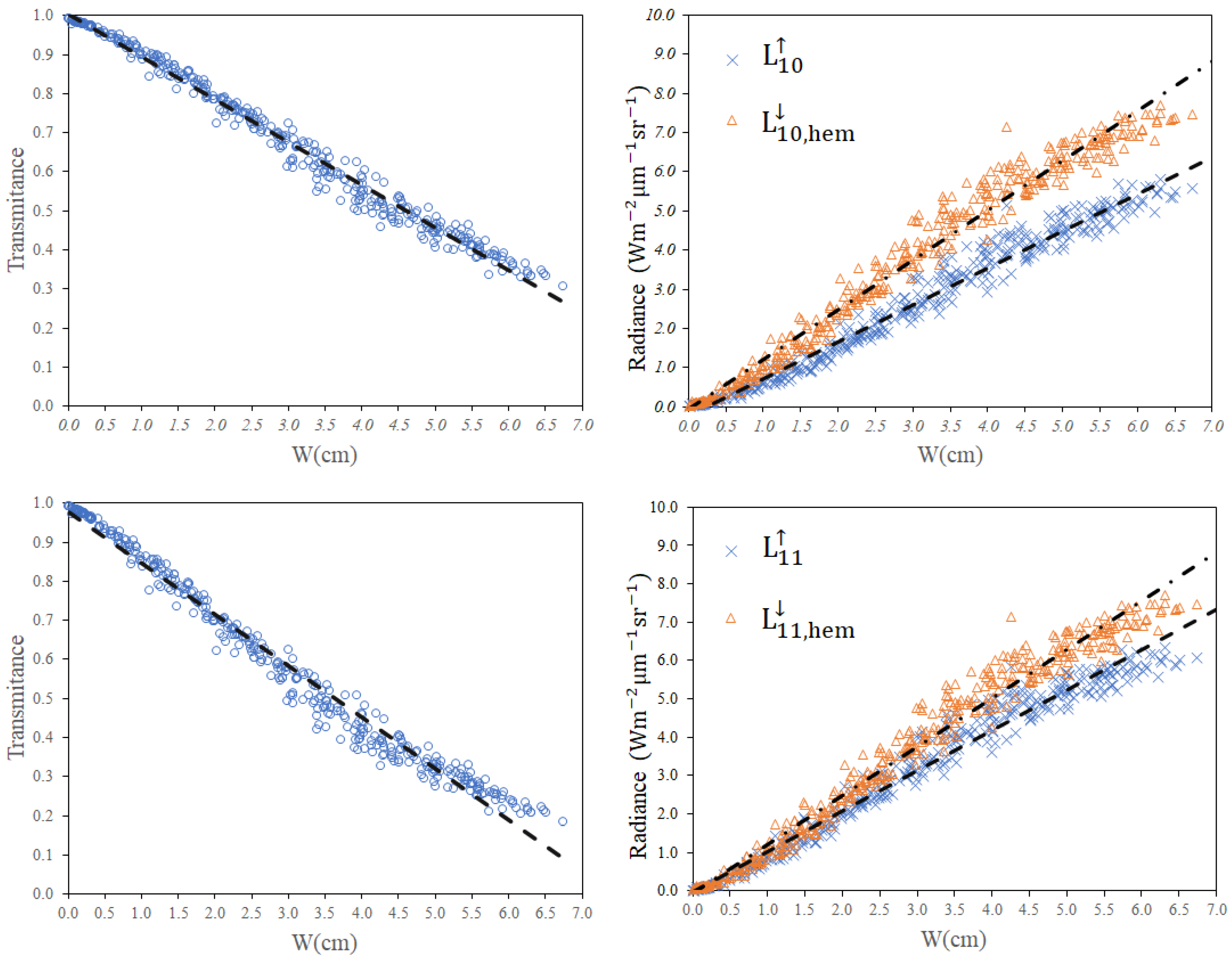
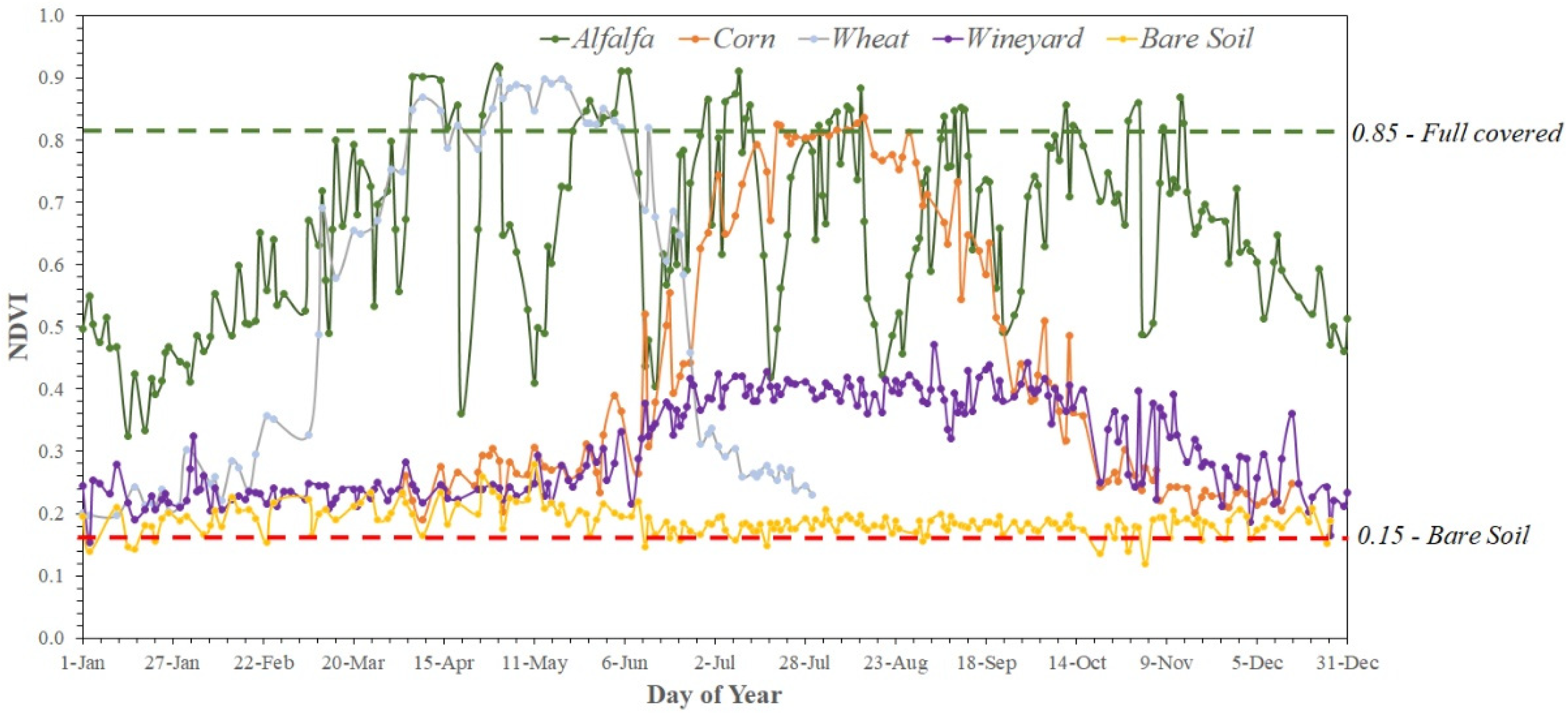
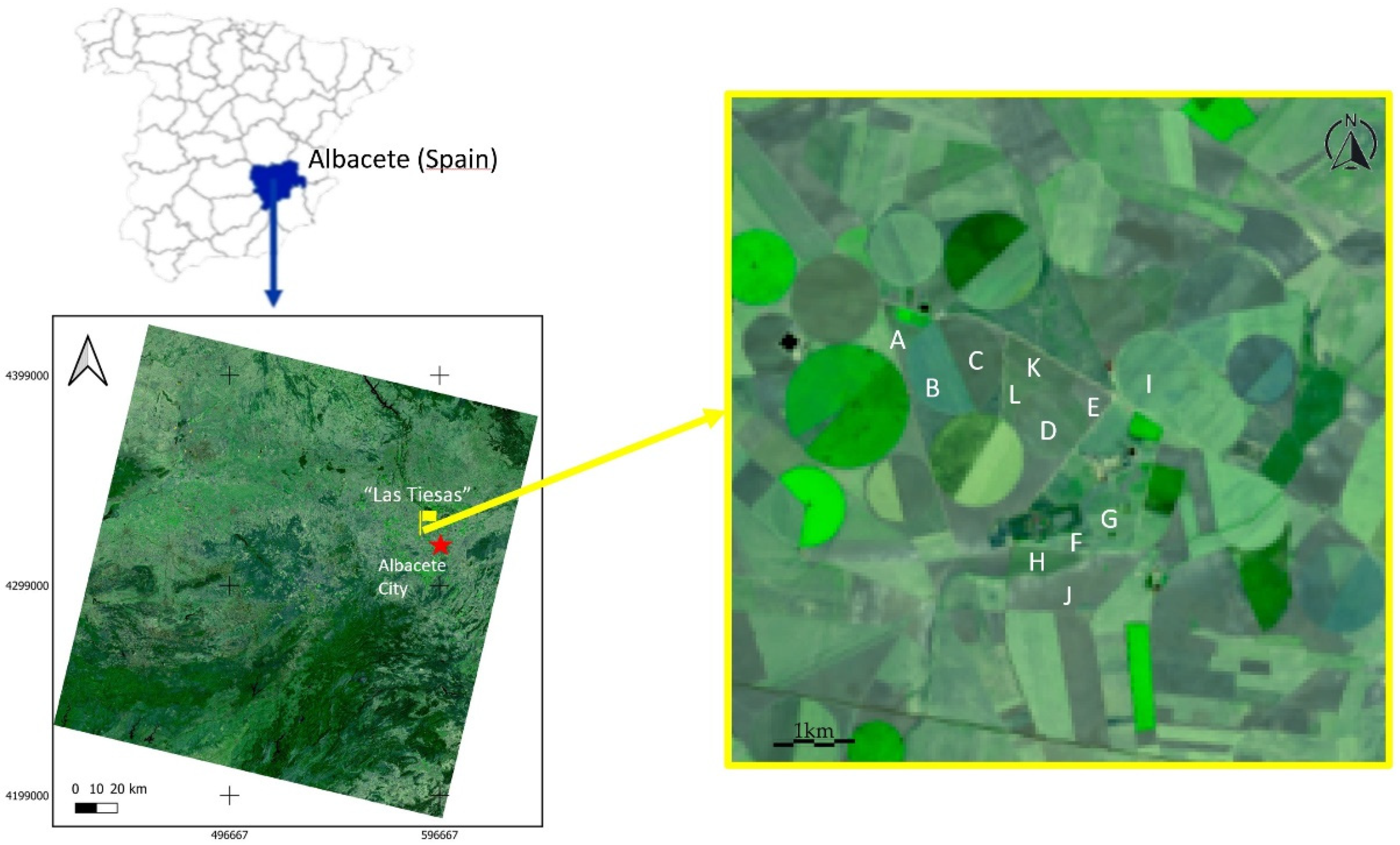
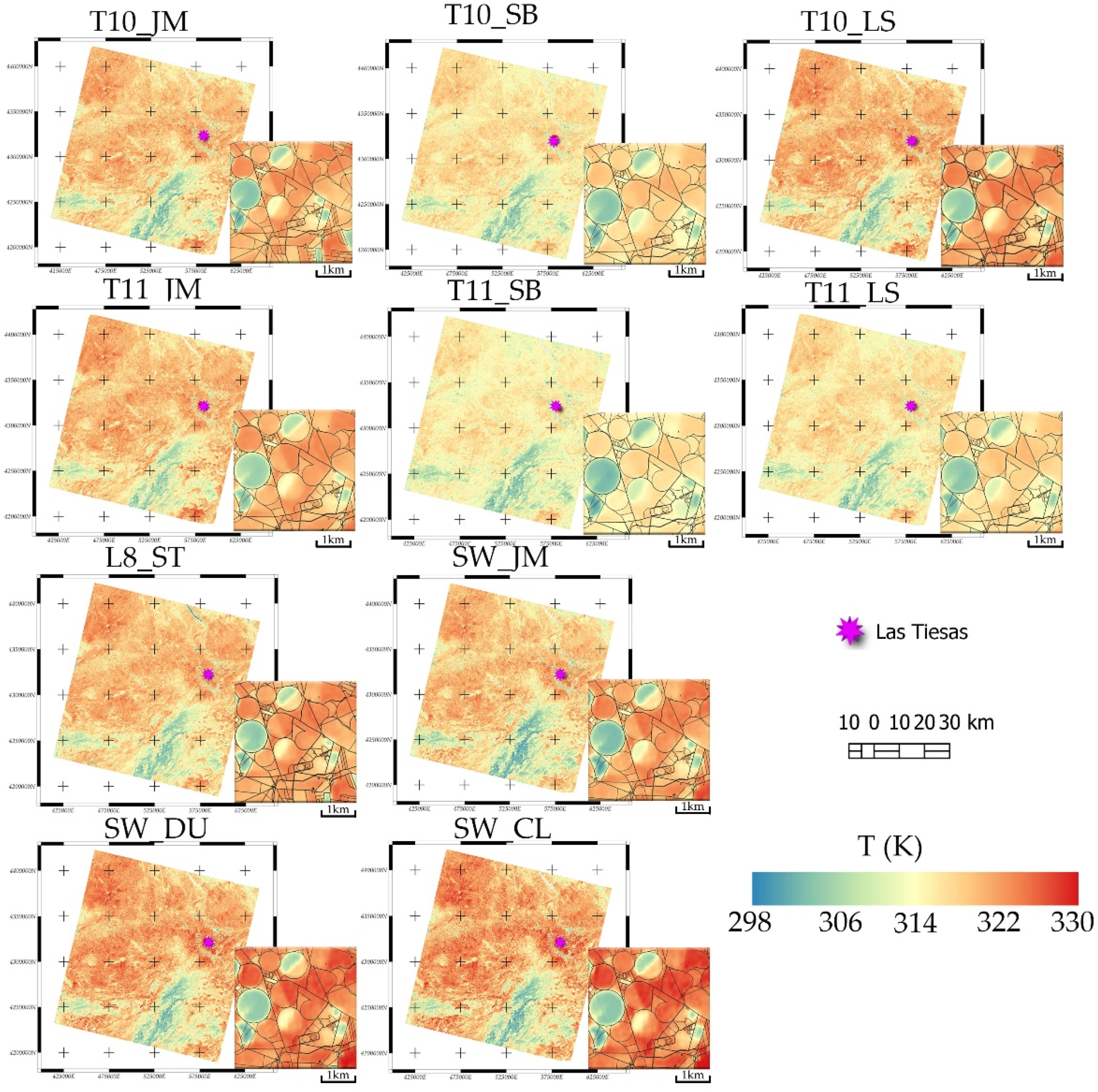
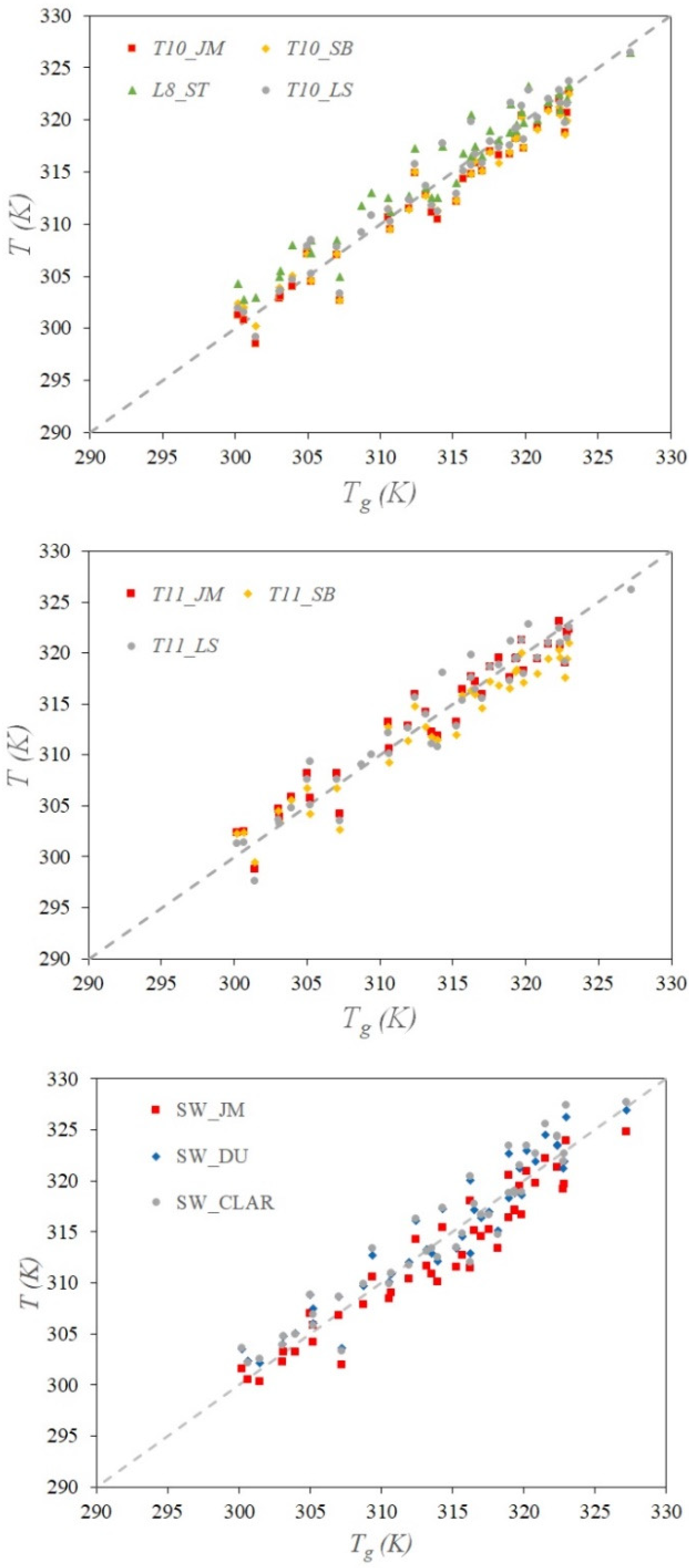
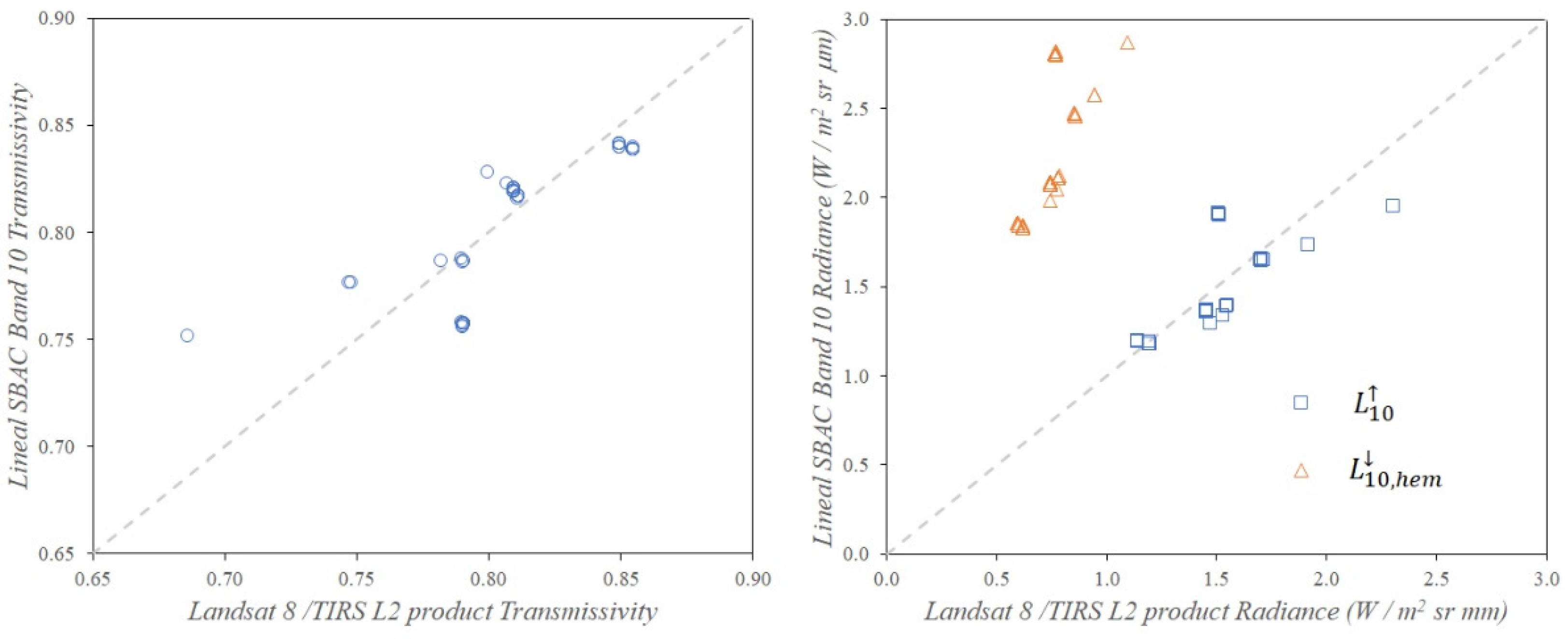

| Sensor/Band | Atmospheric Parameter | a | b | r2 |
|---|---|---|---|---|
| TIRS/Band 10 | −0.1095 ± 0.0007 | 1.004 ± 0.002 | 0.987 | |
| 0.945 ± 0.008 | −0.23 ± 0.03 | 0.974 | ||
| 1.271 ± 0.011 | 0.07 ± 0.04 | 0.974 | ||
| TIRS/Band 11 | −0.1316 ± 0.0010 | 0.978 ± 0.003 | 0.980 | |
| 1.052± 0.010 | −0.04 ± 0.03 | 0.970 | ||
| 1.337 ± 0.013 | 0.26 ± 0.05 | 0.963 |
| # | Date (yyyy/mm/dd) | Path | Row | Crop | Zone | Time (hh:mm) | Lon. (°) | Lat. (°) |
|---|---|---|---|---|---|---|---|---|
| 1 | 2018/06/15 | 199 | 33 | Vineyard | A | 10:45 | 39.0598 | −2.1009 |
| 2 | Poppy | B | 10:45 | 39.0592 | −2.0989 | |||
| 3 | Garlic | C | 10:45 | 39.0592 | −2.0958 | |||
| 4 | Garlic Pivot | D | 10:45 | 39.0529 | −2.0872 | |||
| 5 | Bare Soil | E | 10:45 | 39.0545 | −2.0830 | |||
| 6 | Barley (rainfed) | F | 10:45 | 39.0426 | −2.0877 | |||
| 7 | Barley (irrigation) | G | 10:45 | 39.0450 | −2.0814 | |||
| 8 | Almonds | H | 10:45 | 39.0429 | −2.0895 | |||
| 9 | 2018/06/22 | 200 | 33 | Poppy | B | 10:50 | 39.0592 | −2.0989 |
| 10 | Garlic | C | 10:50 | 39.0592 | −2.0958 | |||
| 11 | Garlic Pivot | D | 10:50 | 39.0529 | −2.0872 | |||
| 12 | Bare Soil | E | 10:50 | 39.0545 | −2.0830 | |||
| 13 | Wheat | I | 10:50 | 39.0561 | −2.0774 | |||
| 14 | Barley (rainfed) | F | 10:50 | 39.0426 | −2.0877 | |||
| 15 | Barley (irrigation) | G | 10:50 | 39.0450 | −2.0814 | |||
| 16 | Bare Soil | J | 10:50 | 39.0402 | −2.0849 | |||
| 17 | Almonds | H | 10:50 | 39.0429 | −2.0895 | |||
| 18 | 2018/07/08 | 200 | 33 | Almonds * | H | 10:45 | 39.0429 | −2.0895 |
| 19 | 2018/07/17 | 199 | 33 | Vineyard | A | 10:50 | 39.0598 | −2.1009 |
| 20 | Bare Soil | E | 10:50 | 39.0545 | −2.0830 | |||
| 21 | Wheat | I | 10:50 | 39.0561 | −2.0774 | |||
| 22 | Barley (rainfed) | F | 10:50 | 39.0426 | −2.0877 | |||
| 23 | Barley (irrigation) | G | 10:50 | 39.0450 | −2.0814 | |||
| 24 | Almonds | H | 10:50 | 39.0429 | −2.0895 | |||
| 25 | 2018/07/24 | 200 | 33 | Vineyard | A | 10:50 | 39.0598 | −2.1009 |
| 26 | Poppy | B | 10:50 | 39.0592 | −2.0989 | |||
| 27 | Bare Soil | E | 10:50 | 39.0545 | −2.0830 | |||
| 28 | Wheat | I | 10:50 | 39.0561 | −2.0774 | |||
| 29 | Barley (rainfed) | F | 10:50 | 39.0426 | −2.0877 | |||
| 30 | Almonds | H | 10:50 | 39.0429 | −2.0895 | |||
| 31 | 2018/08/02 | 199 | 33 | Vineyard | A | 10:45 | 39.0598 | −2.1009 |
| 32 | Bare Soil | E | 10:45 | 39.0545 | −2.0830 | |||
| 33 | Almonds | H | 10:45 | 39.0429 | −2.0895 | |||
| 34 | 2018/08/25 | 200 | 33 | Almonds * | H | 10:48 | 39.0429 | −2.0895 |
| 35 | 2018/10/05 | 199 | 33 | Almonds * | H | 10:42 | 39.0429 | −2.0895 |
| 36 | 2018/10/12 | 200 | 33 | Almonds * | H | 10:48 | 39.0429 | −2.0895 |
| 37 | 2019/07/11 | 200 | 33 | Vineyard | A | 10:35 | 39.0598 | −2.1009 |
| 38 | Onion | B | 10:35 | 39.0592 | −2.0989 | |||
| 39 | Poopy | C | 10:35 | 39.0592 | −2.0958 | |||
| 40 | Stubble | K | 10:35 | 39.0529 | −2.0872 | |||
| 41 | Bare Soil | E | 10:35 | 39.0545 | −2.0830 | |||
| 42 | Almonds | L | 10:35 | 39.0426 | −2.0877 | |||
| 43 | 2019/08/28 | 200 | 33 | Vineyard | A | 10:40 | 39.0450 | −2.0814 |
| 44 | Almonds | L | 10:40 | 39.0429 | −2.0895 |
| # | Tg (°C) | ±σ (°C) | w (cm) | ε10 | T10 (°C) | ±σ (°C) | ε11 | T11 (°C) | ±σ (°C) |
|---|---|---|---|---|---|---|---|---|---|
| 1 | 37.4 | 0.8 | 2.29 | 0.980 | 32.3 | 0.7 | 0.984 | 29.6 | 0.4 |
| 2 | 27.5 | 0.9 | 2.29 | 0.997 | 24.9 | 0.1 | 0.997 | 23.0 | 0.1 |
| 3 | 29.9 | 0.6 | 2.29 | 0.996 | 26.7 | 0.0 | 0.997 | 24.2 | 0.1 |
| 4 | 30.8 | 0.9 | 2.29 | 0.996 | 28.3 | 0.5 | 0.997 | 25.7 | 0.4 |
| 5 | 40.4 | 1.1 | 2.29 | 0.971 | 31.7 | 0.2 | 0.977 | 28.8 | 0.2 |
| 6 | 40.8 | 0.7 | 2.29 | 0.986 | 32.0 | 0.3 | 0.989 | 28.9 | 0.1 |
| 7 | 27.1 | 0.6 | 2.29 | 0.997 | 25.1 | 0.3 | 0.997 | 22.9 | 0.2 |
| 8 | 42.5 | 0.7 | 2.29 | 0.982 | 35.2 | 0.5 | 0.985 | 31.9 | 0.3 |
| 9 | 33.9 | 1.0 | 1.70 | 0.996 | 30.3 | 0.3 | 0.996 | 28.2 | 0.3 |
| 10 | 37.5 | 1.0 | 1.70 | 0.994 | 32.6 | 0.1 | 0.994 | 30.1 | 0.1 |
| 11 | 31.8 | 0.9 | 1.68 | 0.995 | 30.0 | 0.4 | 0.996 | 27.8 | 0.4 |
| 12 | 43.9 | 0.7 | 1.67 | 0.971 | 35.9 | 0.1 | 0.977 | 33.2 | 0.2 |
| 13 | 34.1 | 0.9 | 1.67 | 0.998 | 27.3 | 0.2 | 0.997 | 25.4 | 0.2 |
| 14 | 39.2 | 0.9 | 1.65 | 0.986 | 36.8 | 0.3 | 0.988 | 33.8 | 0.3 |
| 15 | 32.1 | 1.2 | 1.65 | 0.997 | 28.2 | 0.4 | 0.997 | 26.4 | 0.3 |
| 16 | 42.1 | 0.9 | 1.64 | 0.986 | 34.2 | 0.1 | 0.989 | 31.6 | 0.1 |
| 17 | 46.7 | 0.8 | 1.66 | 0.981 | 38.6 | 0.3 | 0.985 | 35.3 | 0.2 |
| 18 | 45.8 | 1.1 | 1.64 | 0.983 | 37.9 | 0.1 | 0.986 | 34.9 | 0.1 |
| 19 | 43.1 | 1.2 | 1.53 | 0.988 | 38.1 | 1.3 | 0.990 | 35.9 | 0.6 |
| 20 | 46.6 | 0.5 | 1.54 | 0.971 | 40.9 | 0.2 | 0.977 | 38.2 | 0.3 |
| 21 | 40.0 | 0.9 | 1.54 | 0.983 | 34.8 | 0.3 | 0.987 | 32.5 | 0.2 |
| 22 | 46.2 | 1.0 | 1.53 | 0.982 | 39.7 | 0.2 | 0.986 | 37.1 | 0.1 |
| 23 | 38.8 | 0.8 | 1.54 | 0.986 | 34.0 | 0.1 | 0.989 | 32.0 | 0.1 |
| 24 | 46.2 | 1.5 | 1.53 | 0.984 | 39.9 | 0.0 | 0.987 | 37.1 | 0.0 |
| 25 | 44.4 | 1.2 | 1.52 | 0.987 | 40.0 | 1.2 | 0.990 | 36.7 | 0.7 |
| 26 | 49.2 | 1.0 | 1.51 | 0.985 | 41.8 | 0.1 | 0.988 | 38.4 | 0.1 |
| 27 | 49.8 | 1.0 | 1.49 | 0.971 | 43.0 | 0.3 | 0.977 | 39.2 | 0.2 |
| 28 | 48.4 | 0.5 | 1.49 | 0.982 | 42.0 | 0.1 | 0.986 | 38.5 | 0.1 |
| 29 | 47.7 | 1.2 | 1.46 | 0.981 | 40.4 | 0.1 | 0.985 | 37.1 | 0.0 |
| 30 | 49.6 | 0.2 | 1.47 | 0.983 | 40.1 | 0.1 | 0.986 | 37.0 | 0.1 |
| 31 | 45.0 | 1.0 | 2.01 | 0.989 | 38.5 | 0.9 | 0.991 | 35.3 | 1.4 |
| 32 | 49.2 | 0.5 | 2.02 | 0.972 | 40.9 | 0.1 | 0.978 | 37.4 | 0.2 |
| 33 | 49.7 | 0.6 | 2.02 | 0.984 | 40.4 | 0.1 | 0.987 | 37.1 | 0.1 |
| 34 | 43.4 | 0.8 | 1.96 | 0.984 | 36.1 | 0.5 | 0.987 | 33.4 | 0.3 |
| 35 | 30.0 | 0.8 | 1.65 | 0.985 | 26.5 | 0.3 | 0.988 | 24.6 | 0.2 |
| 36 | 28.3 | 0.8 | 2.25 | 0.984 | 22.6 | 0.2 | 0.987 | 20.1 | 0.2 |
| 37 | 47.1 | 1.0 | 1.72 | 0.982 | 42.1 | 0.5 | 0.985 | 38.9 | 0.3 |
| 38 | 32.1 | 0.9 | 1.71 | 0.995 | 31.0 | 0.1 | 0.995 | 29.4 | 0.0 |
| 39 | 41.2 | 1.0 | 1.71 | 0.985 | 38.0 | 0.1 | 0.988 | 35.4 | 0.1 |
| 40 | 45.8 | 0.8 | 1.70 | 0.979 | 40.5 | 0.6 | 0.983 | 37.6 | 0.3 |
| 41 | 54.1 | 1.5 | 1.69 | 0.971 | 44.6 | 0.1 | 0.977 | 41.2 | 0.1 |
| 42 | 43.1 | 1.2 | 1.70 | 0.984 | 39.6 | 0.1 | 0.987 | 36.7 | 0.1 |
| 43 | 36.2 | 0.9 | 2.10 | 0.987 | 31.7 | 0.5 | 0.990 | 28.8 | 0.3 |
| 44 | 35.6 | 1.0 | 2.08 | 0.986 | 30.6 | 0.2 | 0.989 | 28.1 | 0.1 |
| N = 44 | SC Algorithms | SW Algorithms | ||||||||
|---|---|---|---|---|---|---|---|---|---|---|
| T10_JM | T11_JM | T10_SB | T11_SB | T10_LS | T11_LS | L8_ST | SW_JM | SW_DU | SW_CLAR | |
| BIAS (K) | −0.6 | 0.6 | −0.5 | −0.7 | 0.2 | 0.1 | 1.0 | −1.2 | 0.7 | 0.9 |
| σ (Κ) | ±1.8 | ±2.0 | ±1.8 | ±2.0 | ±1.8 | ±2.0 | ±1.9 | ±1.9 | ±2.0 | ±2.0 |
| RMSE (K) | ±1.9 | ±2.0 | ±1.8 | ±2.0 | ±1.8 | ±1.9 | ±2.0 | ±2.0 | ±2.0 | ±2.0 |
| MAE (K) | ±1.5 | ±1.7 | ±1.5 | ±1.7 | ±1.4 | ±1.5 | ±1.7 | ±1.9 | ±1.7 | ±1.8 |
| R2 | 0.939 | 0.925 | 0.943 | 0.932 | 0.939 | 0.926 | 0.939 | 0.928 | 0.924 | 0.913 |
| Slope | 0.94 | 0.91 | 0.88 | 0.85 | 0.96 | 0.95 | 0.86 | 0.93 | 0.98 | 0.94 |
| Interception (K) | 17 | 27 | 36 | 47 | 14 | 15 | 45 | 21 | 7 | 18 |
| SC Algorithms | SW Algorithms | |||||||||
|---|---|---|---|---|---|---|---|---|---|---|
| T10_JM | T11_JM | T10_SB | T11_SB | T10_LS | T11_LS | L8_ST | SW_JM | SW_DU | SW_CLAR | |
| Almonds N = 11 (Tg variability = ±0.8 K) | ||||||||||
| BIAS (K) | −1.3 | −0.3 | −1.1 | −1.3 | −0.5 | −0.8 | 0.9 | −1.7 | 0.2 | 0.6 |
| σ (K) | ±1.8 | ±2.1 | ±1.8 | ±2.0 | ±1.8 | ±2.1 | ±1.9 | ±1.6 | ±1.6 | ±1.5 |
| RMSE (K) | ±2.2 | ±2.0 | ±2.0 | ±2.3 | ±1.8 | ±2.1 | ±2.0 | ±2.3 | ±1.5 | ±1.6 |
| MAE (K) | ±1.8 | ±1.6 | ±1.6 | ±1.8 | ±1.4 | ±1.5 | ±1.6 | ±2.1 | ±1.2 | ±1.1 |
| Bare Soil N = 7 (Tg variability = ±0.9 K) | ||||||||||
| BIAS (K) | −1.3 | −0.5 | −1.4 | −2.1 | −0.4 | −0.9 | −0.3 | −1.6 | 0.4 | 1.0 |
| σ (K) | ±1.4 | ±1.2 | ±1.2 | ±1.2 | ±1.4 | ±1.4 | ±0.8 | ±1.6 | ±1.7 | ±2.0 |
| RMSE (K) | ±1.8 | ±1.3 | ±1.8 | ±2.4 | ±1.4 | ±1.6 | ±0.8 | ±2.2 | ±1.6 | ±2.1 |
| MAE (K) | ±1.3 | ±1.0 | ±1.4 | ±1.9 | ±1.1 | ±1.2 | ±0.6 | ±1.7 | ±1.2 | ±1.4 |
| Wheat/Barley N = 10 (Tg variability = ±1.0 K) | ||||||||||
| BIAS (K) | −0.9 | 0.1 | −0.8 | −1.1 | −0.1 | −0.3 | 0.7 | −1.3 | 0.6 | 0.8 |
| σ (K) | ±2.0 | ±2.0 | ±2.1 | ±2.1 | ±2.0 | ±2.0 | ±2.3 | ±2.2 | ±2.3 | ±2.6 |
| RMSE (K) | ±2.1 | ±1.9 | ±2.1 | ±2.3 | ±1.9 | ±2.0 | ±2.3 | ±2.4 | ±2.3 | ±2.6 |
| MAE (K) | ±1.6 | ±1.5 | ±1.7 | ±1.9 | ±1.4 | ±1.5 | ±1.7 | ±2.0 | ±1.8 | ±2.0 |
| Garlic N = 4 (Tg variability = ±0.9 K) | ||||||||||
| BIAS (K) | 0.2 | 1.7 | 0.8 | 0.9 | 0.9 | 0.9 | 2.4 | −0.3 | 1.6 | 1.5 |
| σ (K) | ±1.4 | ±1.3 | ±1.4 | ±1.5 | ±1.4 | ±1.3 | ±1.5 | ±1.6 | ±1.6 | ±1.6 |
| RMSE (K) | ±1.2 | ±2.0 | ±1.4 | ±1.5 | ±1.5 | ±1.4 | ±2.7 | ±1.4 | ±2.1 | ±2.1 |
| MAE (K) | ±0.7 | ±1.3 | ±1.1 | ±1.2 | ±0.9 | ±0.9 | ±1.9 | ±1.0 | ±1.2 | ±1.2 |
| Poppy N = 4 (Tg variability = ±1.0 K) | ||||||||||
| BIAS (K) | 0.3 | 1.4 | 0.4 | 0.1 | 1.1 | 0.9 | 1.4 | −0.1 | 1.9 | 2.0 |
| σ (K) | ±1.7 | ±2.3 | ±1.7 | ±2.2 | ±1.7 | ±2.1 | ±1.9 | ±0.9 | ±0.8 | ±0.7 |
| RMSE (K) | ±1.5 | ±2.4 | ±1.5 | ±1.9 | ±1.8 | ±2.1 | ±2.2 | ±0.8 | ±2.0 | ±2.1 |
| MAE (K) | ±1.1 | ±2.1 | ±1.3 | ±1.6 | ±1.4 | ±1.6 | ±2.0 | ±0.6 | ±1.9 | ±2.0 |
| Vineyard N = 6 (Tg variability = ±1.0 K) | ||||||||||
| BIAS (K) | −0.2 | 1.8 | −0.1 | 0.4 | 0.7 | 1.3 | 1.7 | −2.0 | −0.2 | −0.3 |
| σ (K) | ±1.3 | ±0.7 | ±1.6 | ±1.2 | ±1.3 | ±0.7 | ±1.5 | ±2.6 | ±2.8 | ±3.3 |
| RMSE (K) | ±1.2 | ±1.9 | ±1.4 | ±1.2 | ±1.3 | ±1.5 | ±2.2 | ±3.1 | ±2.6 | ±3.1 |
| MAE (K) | ±1.0 | ±1.8 | ±1.3 | ±0.9 | ±1.1 | ±1.3 | ±1.7 | ±2.6 | ±2.2 | ±2.7 |
| N = 44 | T10–T11 | ||
|---|---|---|---|
| JM | SBAC | L-SBAC | |
| BIAS (K) | −1.2 | 0.2 | 0.1 |
| σ (Κ) | ±0.7 | ±0.6 | ±0.6 |
| RMSE (K) | ±1.4 | ±0.7 | ±0.6 |
| MAE (K) | ±1.2 | ±0.5 | ±0.5 |
Publisher’s Note: MDPI stays neutral with regard to jurisdictional claims in published maps and institutional affiliations. |
© 2022 by the authors. Licensee MDPI, Basel, Switzerland. This article is an open access article distributed under the terms and conditions of the Creative Commons Attribution (CC BY) license (https://creativecommons.org/licenses/by/4.0/).
Share and Cite
Galve, J.M.; Sánchez, J.M.; García-Santos, V.; González-Piqueras, J.; Calera, A.; Villodre, J. Assessment of Land Surface Temperature Estimates from Landsat 8-TIRS in A High-Contrast Semiarid Agroecosystem. Algorithms Intercomparison. Remote Sens. 2022, 14, 1843. https://doi.org/10.3390/rs14081843
Galve JM, Sánchez JM, García-Santos V, González-Piqueras J, Calera A, Villodre J. Assessment of Land Surface Temperature Estimates from Landsat 8-TIRS in A High-Contrast Semiarid Agroecosystem. Algorithms Intercomparison. Remote Sensing. 2022; 14(8):1843. https://doi.org/10.3390/rs14081843
Chicago/Turabian StyleGalve, Joan M., Juan M. Sánchez, Vicente García-Santos, José González-Piqueras, Alfonso Calera, and Julio Villodre. 2022. "Assessment of Land Surface Temperature Estimates from Landsat 8-TIRS in A High-Contrast Semiarid Agroecosystem. Algorithms Intercomparison" Remote Sensing 14, no. 8: 1843. https://doi.org/10.3390/rs14081843
APA StyleGalve, J. M., Sánchez, J. M., García-Santos, V., González-Piqueras, J., Calera, A., & Villodre, J. (2022). Assessment of Land Surface Temperature Estimates from Landsat 8-TIRS in A High-Contrast Semiarid Agroecosystem. Algorithms Intercomparison. Remote Sensing, 14(8), 1843. https://doi.org/10.3390/rs14081843









